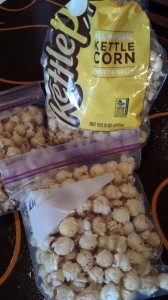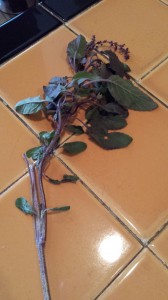People often ask, how do I start practicing dhamma? Where do I begin? With kettle corn and holy basil. Let me explain.
I went to the farmer’s market today and picked up grapes, raw peanuts, and a bunch of lemon basil from our usual Hmong vendor. I asked him if there was any holy basil hiding in one of their boxes. He said they had sold out and laughed as he put a straggler stem of holy basil in the bag with my other groceries.
Then I walked up the block to the food vendors, thinking that I should buy a snack for my employees. Warm kettle corn seemed like a good option. It came in three sizes. The small one might not be enough, while the large one seemed like way too much. I bought the medium-sized bag.
 When I got back to work, I boiled the peanuts and put out three bowls of snacks: peanuts, grapes, and kettle corn. It seemed like the grapes and peanuts were popular, but the kettle corn wasn’t as big a hit as I had hoped. I looked at the seemingly overflowing medium-sized bag that suddenly seemed like a bad idea. I will probably have to eat all of it if no one else likes it. That’ll take me forever. No, I have to give some of this away while it’s still fresh. I poured some of the kettle corn into ziploc bags, and wondered who I should give them to. I didn’t want to give it to someone who would just toss it out. I began to feel a bit antsy every time I looked at the bags.
When I got back to work, I boiled the peanuts and put out three bowls of snacks: peanuts, grapes, and kettle corn. It seemed like the grapes and peanuts were popular, but the kettle corn wasn’t as big a hit as I had hoped. I looked at the seemingly overflowing medium-sized bag that suddenly seemed like a bad idea. I will probably have to eat all of it if no one else likes it. That’ll take me forever. No, I have to give some of this away while it’s still fresh. I poured some of the kettle corn into ziploc bags, and wondered who I should give them to. I didn’t want to give it to someone who would just toss it out. I began to feel a bit antsy every time I looked at the bags.
 Then, I decided to cut the basil leaves. I brought the holy basil to the table with me. In the Laotion language, there’s a term for this: ka-tern. It’s not enough, yet too much. There wasn’t enough basil for a single serving, yet it was a waste to toss out because holy basil is hard to come by. I packed up the lemon basil leaves and took the holy basil to another area with me. I must have moved it at least ten times before I swore never to look at it again. I never knew that a (free of charge) single stem of holy basil could weigh so heavily on my heart.
Then, I decided to cut the basil leaves. I brought the holy basil to the table with me. In the Laotion language, there’s a term for this: ka-tern. It’s not enough, yet too much. There wasn’t enough basil for a single serving, yet it was a waste to toss out because holy basil is hard to come by. I packed up the lemon basil leaves and took the holy basil to another area with me. I must have moved it at least ten times before I swore never to look at it again. I never knew that a (free of charge) single stem of holy basil could weigh so heavily on my heart.
What does this have to do with dhamma practice? Dhamma practice starts with suffering, with an issue to be resolved. Well, many people say that they don’t have any suffering in their lives, that everything is fine. But, really, who hasn’t felt some level of anxiety because of something like this? Whether you made a decision that didn’t work out how you anticipated, or you were given something that became a burden, we’ve all experienced the unease and frustration. So start with that. It may not appear to be extreme enough to be labeled “suffering,” but any negative feeling that must be tolerated falls under the umbrella of “suffering.”
Once you’ve identified that negative feeling, you can fix it. You can trace back to where it began, what caused it, what aggravated it. What thoughts made it better? What made it worse? What did you think was going to happen for sure? If you keep track of it, you will see whether it happens how you imagined it. Once you’ve identified the permanence in your thoughts, you can work on understanding how that permanence is only one side of it. You can open up your mind to the many other possibilities. Lastly, once you have felt the suffering first-hand and can identify the harmful consequences that come from this, you can work on changing your behavior.
For instance, if I felt it was certain that no one at work would eat the kettle corn, and that I would have to give away the rest of the bag, how could that make me think and behave? I might end focusing on the bowl of kettle corn on the table, pressuring my employees to eat more kettle corn, just one handful, just one more piece. Could that irritate them? What are the long-term effects of that? And what about the people I gave the kettle corn to? Would I just leave it at that, or would I check up on them to make sure they ate it? What could happen in the future? What if they thought I really really liked kettle corn and bought me a big bag? Then what would I do? What if they wanted to give me something in return, and then I had to give them something in return? What have I started? And so on. (tip: Mae Yo always reminds me to tie my contemplations into the four elements, self and self belongings, and the intangible aggregates. And don’t forget suffering, harmful consequences, and future perils).
So, to those who say they have nothing to think about, they don’t know how to begin or to jump-start their stagnant practice, I say, it’s all in the kettle corn and holy basil. Good luck!
No Comments